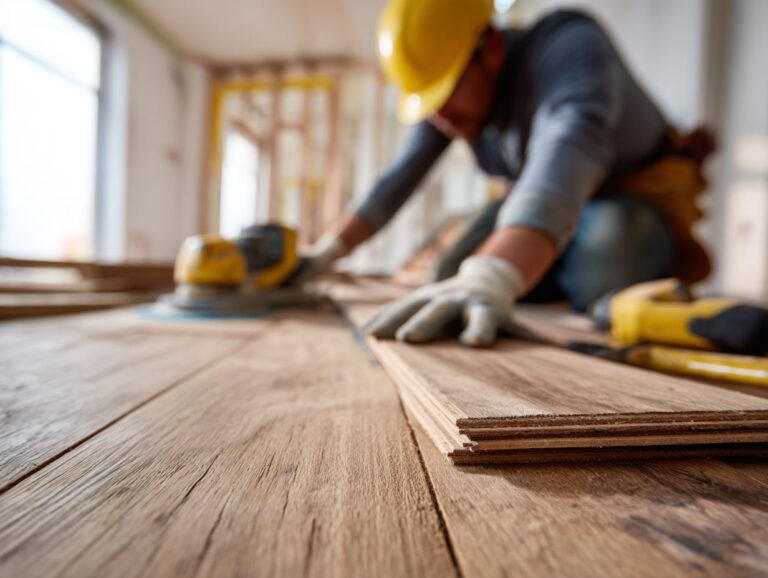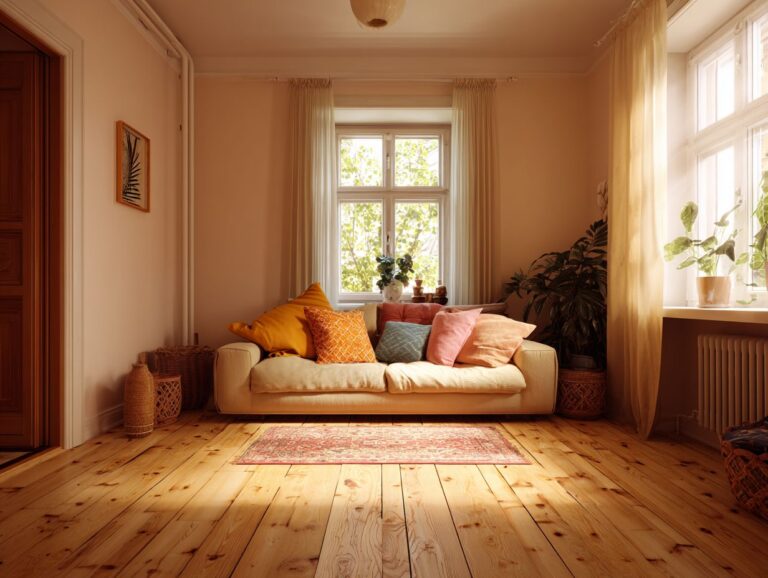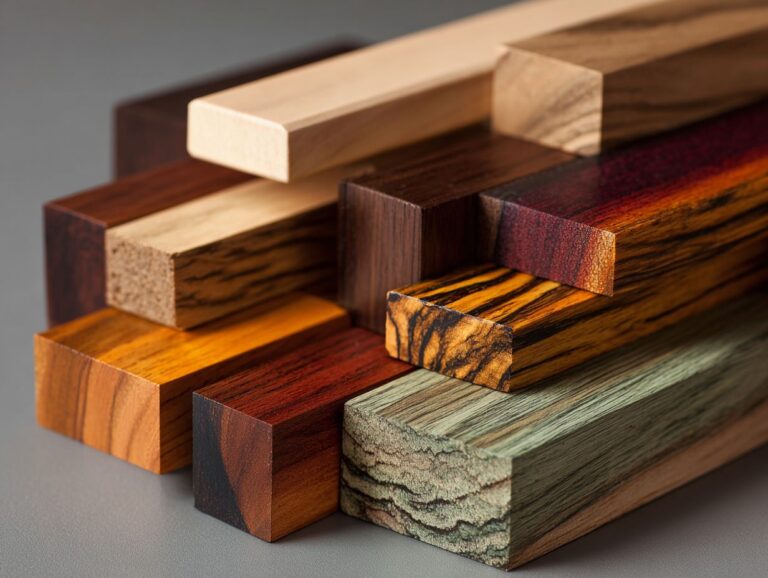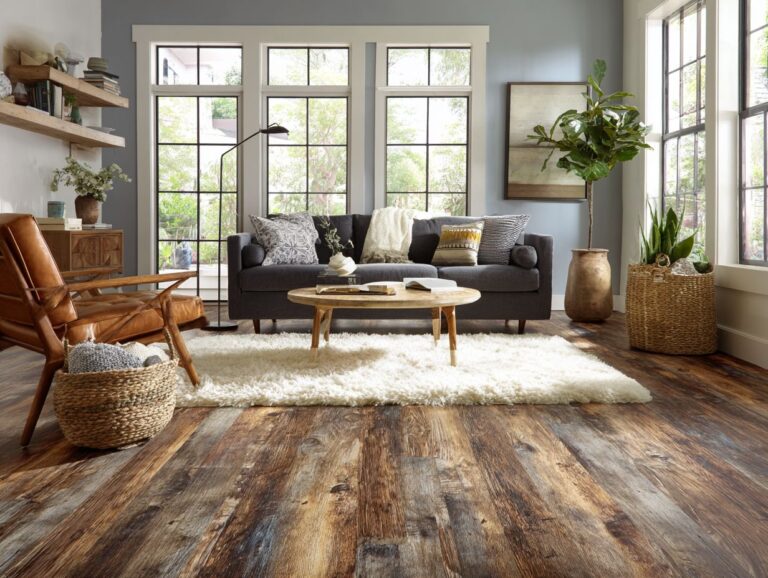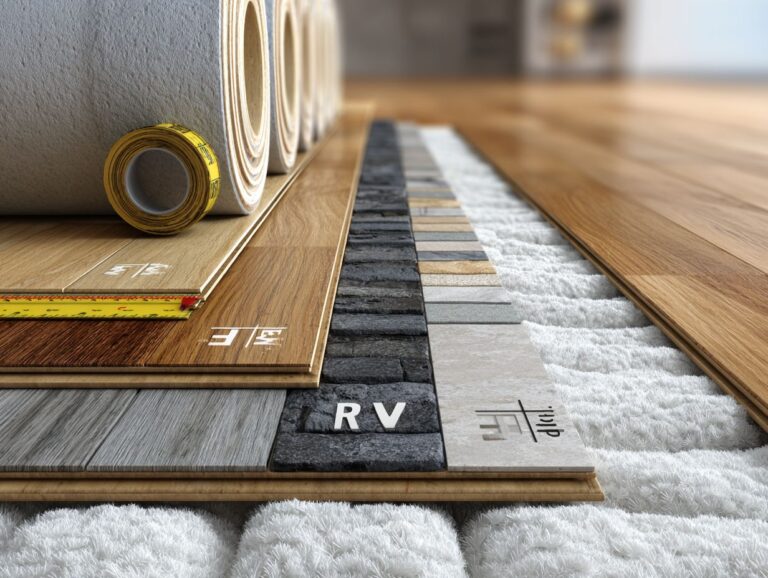Non-Toxic Flooring Materials – Chemical-Free Homes
Choosing non-toxic flooring is essential for a healthier home, free from toxic flooring materials and harmful volatile organic compounds. In Britain, brands like Atkinson & Kirby offer stunning options like solid and engineered hardwood flooring that prioritize your well-being. This article will guide you through the best chemical-free flooring choices, showcasing their benefits and helping you create a safe, stylish environment for you and your family. Learn how easy decisions can improve the air quality and look of your home!
Key Takeaways:
Contents
- Non-Toxic Flooring Usage and Risks
- Types of Non-Toxic Flooring Materials
- Benefits of Non-Toxic Flooring
- Choosing the Right Non-Toxic Flooring
- Care and Maintenance for Non-Toxic Floors
- Common Myths about Non-Toxic Flooring
- Frequently Asked Questions
- What are non-toxic flooring materials?
- Why should I choose non-toxic flooring materials for my home?
- What are some examples of non-toxic flooring materials?
- Are all non-toxic flooring materials expensive?
- Can non-toxic flooring materials be used in all rooms of the house?
- Do non-toxic flooring materials require special maintenance?
Importance of Chemical-Free Homes
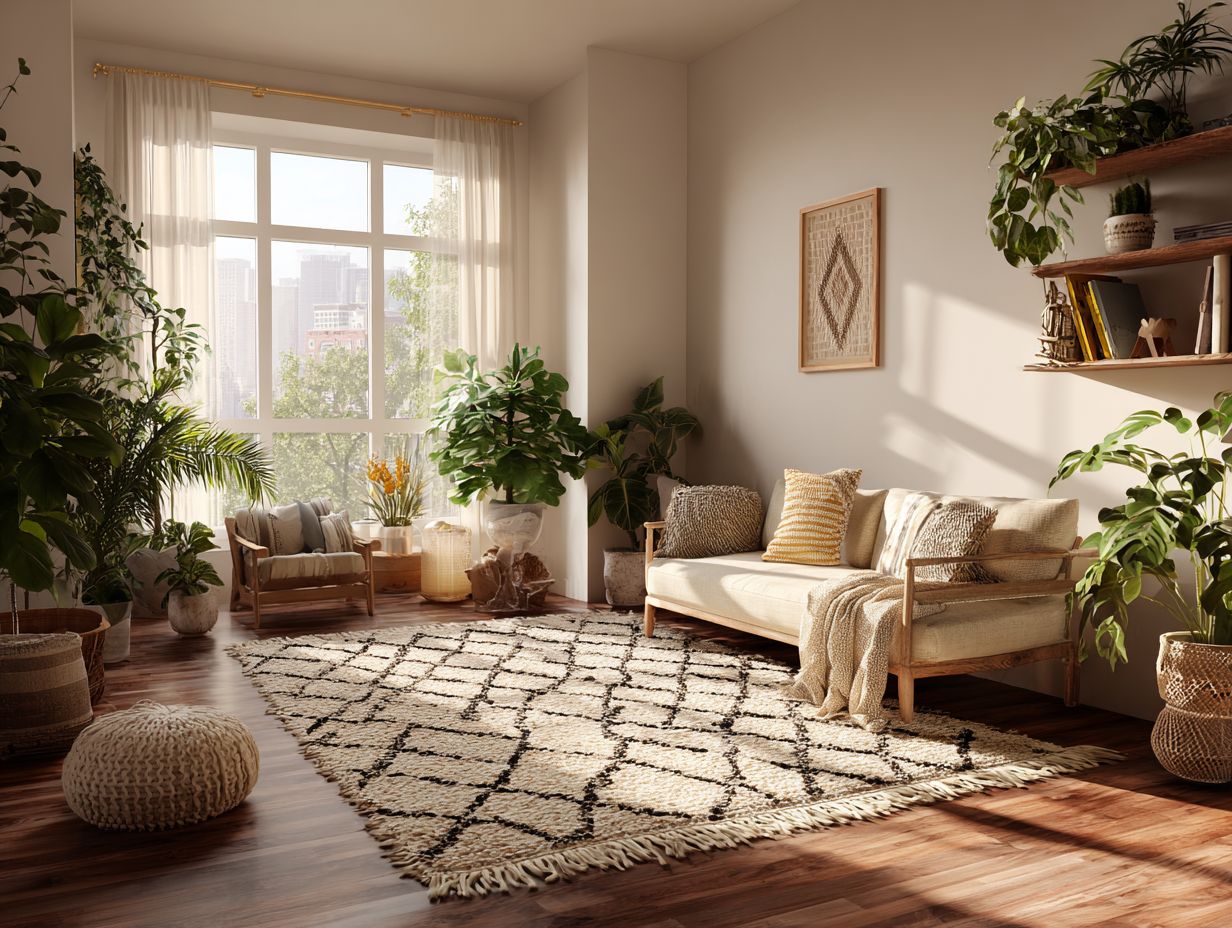
Creating a chemical-free home can significantly improve indoor air quality, as studies show that VOC levels can rise by 200% due to common household materials.
To mitigate health risks from toxic flooring, focus on materials that emit low or no volatile organic compounds (VOCs). For example, bamboo and cork flooring are both sustainable and safe choices.
Look for adhesives and finishes labeled as low-VOC or zero-VOC, such as water-based options. Consider ceramic tiles or untreated hardwood, which typically have lower formaldehyde levels.
Always look for certifications like Greenguard Gold, which guarantees strict safety standards. By selecting these non-toxic materials, you can create a healthier living environment for you and your family.
Non-Toxic Flooring Usage and Risks
Non-Toxic Flooring Usage and Risks
Non-Toxic and Toxic Flooring Statistics: Chemical Exposure and Risks
The Non-Toxic Flooring Usage and Risks Information shows how non-toxic flooring can greatly reduce health risks linked with regular flooring materials. Knowing how flooring affects health is important for creating safer homes, especially for people who react to chemical emissions and allergens.
Non-Toxic and Toxic Flooring Statistics highlight the impact of using non-toxic materials. A key finding is the 90% reduction in formaldehyde emissions with the use of NAUF (No Added Urea Formaldehyde) products. Formaldehyde is a volatile organic compound (VOC) commonly found in various building materials, and it can cause respiratory problems and other health issues. By reducing these emissions, NAUF products significantly improve indoor air quality.
- Allergens and Sensitivities: The data indicates that 40% of the UK population is affected by allergens, highlighting the need for hypoallergenic flooring options that minimize allergen accumulation. Additionally, 85% of asthmatics are sensitive to dust mites, which are commonly found in carpets and certain types of flooring. Selecting non-toxic, easy-to-clean flooring can help reduce exposure to allergens and improve health outcomes for sensitive individuals.
The statistics underline the importance of choosing non-toxic flooring to minimize harmful chemical exposure and allergen presence. By opting for materials that emit fewer VOCs and are less likely to harbor allergens, individuals can create healthier indoor environments, especially for those with asthma or allergies. This data serves as a call to action for consumers and manufacturers to prioritize health-conscious building materials in residential and commercial spaces.
Overview of Non-Toxic Flooring Materials
Non-toxic flooring encompasses various materials, including solid and engineered hardwood flooring, cork, and natural stone, each offering unique benefits for health-conscious consumers.
Solid hardwood is strong and lasts a long time, with an attractive look. Make sure to get it from reliable sources to keep VOC levels low.
Engineered hardwood offers similar aesthetics with greater stability, suitable for areas prone to humidity. Cork, derived from sustainable bark, acts as a natural insulator and provides cushioning underfoot while boasting anti-microbial properties.
Natural stone, like slate or limestone, often features minimal VOC emissions. Look for certifications such as Floor Score and Greenguard, which guarantee that these materials meet stringent safety standards suitable for homes, especially in children’s play areas. This approach aligns with the principles outlined in our analysis of eco-friendly flooring trends that focus on sustainability and health.
Types of Non-Toxic Flooring Materials
There are many options for non-toxic flooring materials, each offering different characteristics and advantages, suitable for various looks and purposes.
Hardwood Flooring
Hardwood flooring, whether solid or engineered, is a popular choice for its durability and aesthetic appeal, often featuring low VOC finishes.
Solid hardwood consists of a single piece of timber, offering exceptional longevity and the ability to be refinished multiple times.
Engineered hardwood, on the other hand, is made of layers, with a hardwood veneer on top, providing more stability and resistance to moisture.
Both types can be installed using nail-down, glue-down, or floating methods.
Atkinson & Kirby are known for their environmentally friendly choices, emphasizing finishes with low volatile organic compounds (VOC) to improve indoor air quality.
For maintenance, regular sweeping and occasional refinishing will keep your floors looking pristine.
Bamboo Flooring
Bamboo flooring is becoming more popular because it grows quickly and can be replaced easily, making it a good option for homeowners looking for environmentally friendly choices.
Bamboo flooring is environmentally friendly and very durable, often stronger than regular hardwoods, making it a lasting choice for areas with a lot of foot traffic. It emits low levels of volatile organic compounds (VOCs), contributing to better indoor air quality.
When choosing bamboo flooring, pick options approved by groups like the Forest Stewardship Council (FSC) or the Sustainable Forestry Initiative (SFI) to confirm they come from eco-friendly sources.
Bamboo provides a range of looks, from natural patterns to darkened finishes, giving homeowners options to match their decor.
Cork Flooring
Cork flooring, made from the bark of cork oak trees, offers comfort and is environmentally friendly, making it a good choice for homes that want to avoid harmful substances.
Its natural insulation keeps it warm or cool as needed, and it absorbs sound to make the area quieter, which is perfect for apartments.
Cork flooring is antimicrobial, reducing allergens and bacteria on the surface. When buying cork, check for labels like the Forest Stewardship Council (FSC) that confirm responsible collection methods.
This method of gathering cork does not harm the trees, allowing them to live for over 200 years. Choosing cork flooring is a good choice for people who want to live in a way that is better for the environment because it uses methods that are less harmful.
Linoleum Flooring
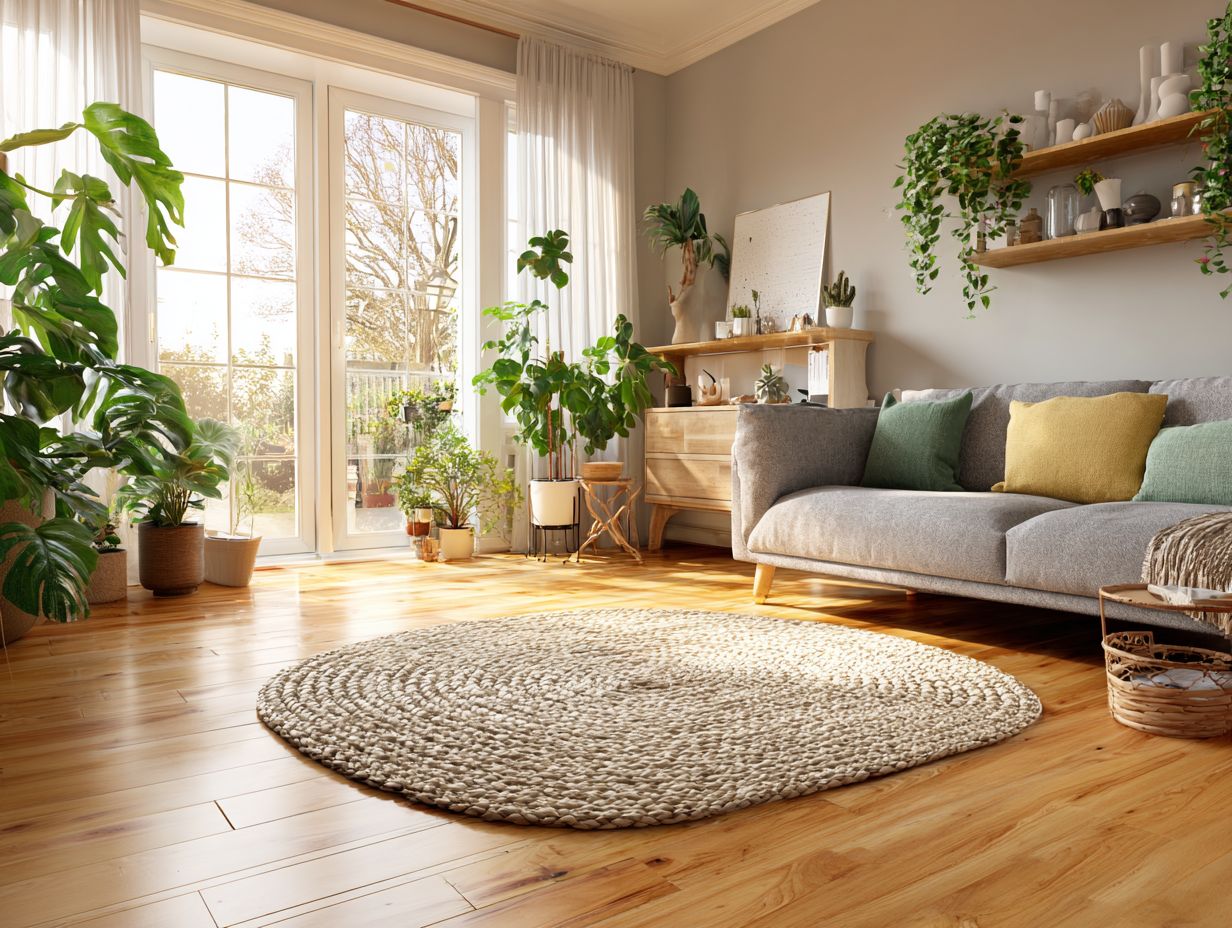
Linoleum, made from natural materials like linseed oil and jute, is a resilient flooring option that is both biodegradable and low in VOC emissions.
It is strong and great for busy places, holding up well against scratches and dents.
Linoleum offers a wide range of designs, from traditional marbled patterns to contemporary geometric prints, providing various style options.
Brands such as Forbo and Armstrong provide non-toxic choices that improve indoor air quality.
You can install it yourself with glue-down or interlocking tiles, which many homeowners find easy.
With proper care, including regular sweeping and occasional damp mopping, linoleum can last up to 40 years, providing lasting beauty and functionality.
Natural Stone Flooring
Natural stone flooring, such as slate and marble, is prized for its beauty and longevity, providing a timeless flooring solution without harmful chemicals.
Beyond aesthetics, natural stone flooring is incredibly durable, resisting scratches and dents better than many synthetic options.
For instance, marble adds elegance to living areas, while slate’s rough texture is perfect for high-traffic zones like kitchens.
Maintenance is minimal; simply sweeping and occasional sealing keeps them looking new.
It’s essential to consider environmental impacts, as stone extraction can harm ecosystems. Opt for companies that adhere to sustainable practices, ensuring responsible sourcing and treatment, which mitigates those concerns.
Recycled Rubber Flooring
Recycled rubber flooring is a fresh, safe choice that reuses materials, making it an eco-friendly option for homes and businesses.
Its durability makes it suitable for places like gyms and play areas where strong materials are necessary.
Recycled rubber flooring provides excellent slip resistance, reducing the risk of accidents. With a variety of designs, from sleek modern looks to colorful patterns, it caters to diverse aesthetics.
Low VOC emissions improve indoor air quality, making it safe for places where children and pets are present. This versatility and safety profile make it a top choice for many applications.
Benefits of Non-Toxic Flooring
Non-toxic flooring offers several advantages, like improving air quality inside, providing more comfort, and looking nice, making it a wise choice. For maintaining these benefits, consider using green cleaning solutions that are compatible with all flooring types.
Health Benefits
The health benefits of choosing non-toxic flooring include reduced exposure to harmful substances like VOCs, leading to improved indoor air quality and overall well-being.
Studies show that homes with non-toxic flooring report up to a 30% reduction in asthma attacks among children. Switching to materials like bamboo or cork can decrease allergy symptoms as these substances resist mold and dust mites.
Tools such as the Green Seal Certification help you identify safe products. It’s advisable to consult with vendors about the off-gassing periods of materials and to consider using low-emission adhesives to maximize health benefits.
Choosing these options enhances your home and supports your health over time.
Environmental Impact
Opting for non-toxic flooring materials significantly reduces environmental impact by minimizing reliance on synthetic products and supporting sustainable sourcing practices.
These flooring options often come from renewable resources like bamboo or cork, which can regenerate quickly.
Certifications like FloorScore and GreenGuard confirm that products meet strict chemical emissions standards, helping to improve indoor air quality.
By choosing these materials, homeowners can also support recycling initiatives-many non-toxic options are designed to be recyclable at the end of their life cycle.
This helps reduce landfill waste, contributing to lower overall carbon footprints associated with production and disposal.
Durability and Maintenance
Non-toxic flooring options are made to be strong and easy to care for, providing lasting appearance and use in busy areas.
Bamboo, cork, and reclaimed hardwood are excellent choices.
Bamboo stands up well to water and scratches, so it’s a great choice for kitchens. For maintenance, simply clean with a damp cloth and a pH-neutral cleaner.
Cork feels gentle underfoot and resists bacteria on its own. You should put natural oil on it every few years to maintain its condition.
Reclaimed hardwood boasts character and durability, benefiting from regular dusting and a hardwood floor cleaner.
These methods keep your flooring in excellent shape and reduce harm to the environment.
Choosing the Right Non-Toxic Flooring
Choosing non-toxic flooring means looking at things like the type of material, price, and how it’s installed to choose the best option for your home. For those interested in keeping up with the latest in sustainable choices, exploring eco-friendly flooring trends can provide valuable insights into sustainable options.
Factors to Consider
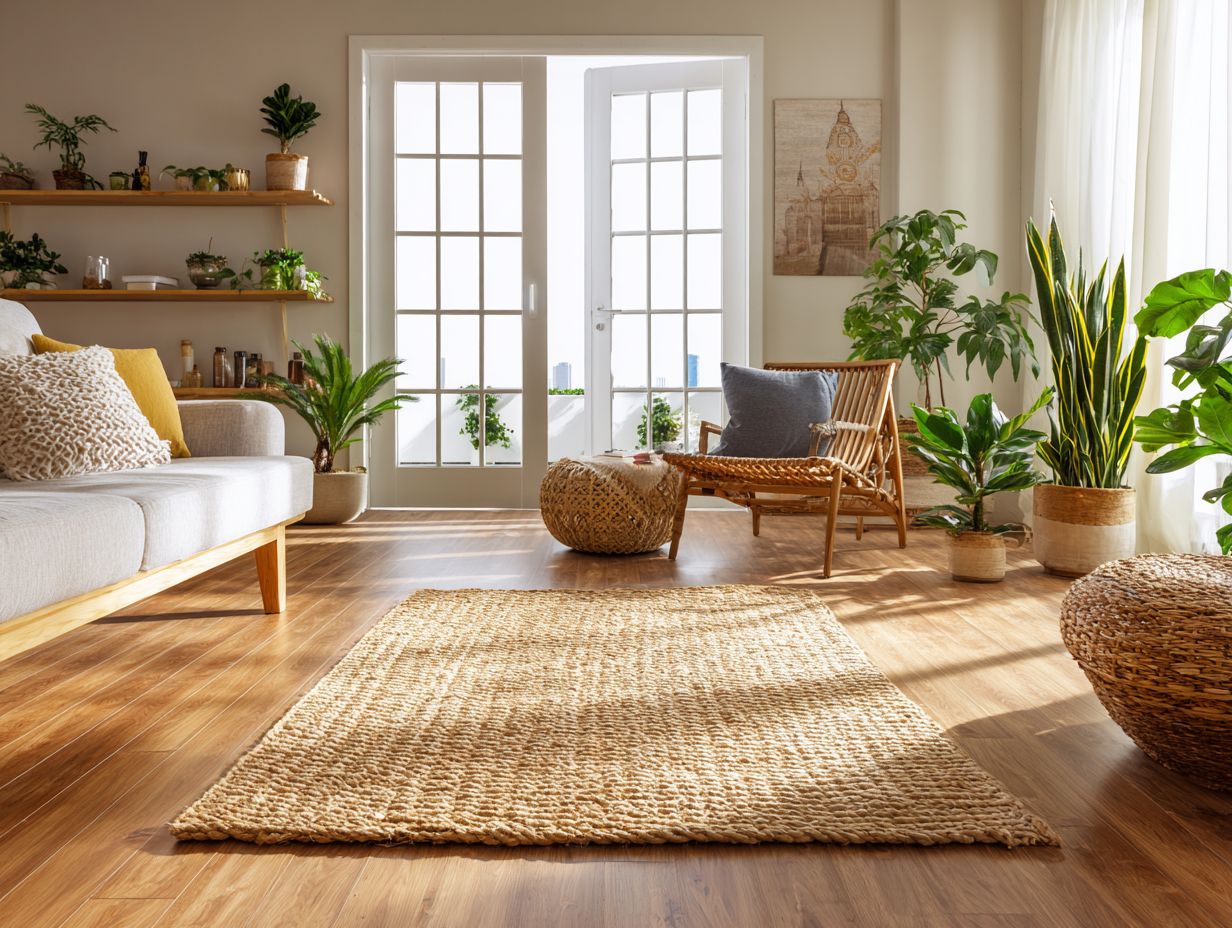
Key factors to consider when choosing non-toxic flooring include the specific needs of your household, durability, maintenance, and overall environmental impact.
First, assess your household’s specific needs: do you have pets or young children?
For durability, look for options like bamboo or cork, which are both resilient and eco-friendly. Looking after your flooring matters; consider vinyl or laminate, as they are easy to clean. Make sure they are labeled as non-toxic.
Evaluate the environmental impact by selecting floors with certifications such as Greenguard or FSC. Studying these factors helps you make a long-lasting decision that fits your family’s way of living.
Cost Comparison
Knowing the price of safe flooring can help homeowners choose wisely, ensuring health and sustainability.
For a cost comparison, consider these common non-toxic flooring materials:
| Material | Avg. Price/SF | Installation Cost/SF |
|---|---|---|
| Bamboo | $3 – $6 | $1 – $2 |
| Cork | $4 – $8 | $1.50 – $2.50 |
| Linoleum | $2 – $7 | $1 – $3 |
| Reclaimed Wood | $5 – $15 | $2 – $5 |
Prices can vary based on brand and sourcing methods, with eco-friendly brands often commanding a premium. To create an exact budget, consider the cost of materials and the fees for installation.
Installation Options
Non-toxic flooring can be put in using different methods, from hiring a professional to doing it yourself, depending on the material and the homeowner’s skill level.
The most popular installation methods include:
- Glue-down
- Nail-down
- Floating options
For glue-down vinyl, make sure the subfloor is clean, and spread the adhesive evenly for a proper fit.
Hardwood flooring installation needs careful choice of nails and spacing. Hiring an expert can help reduce errors.
Floating floors are the easiest for DIY enthusiasts, simply interlocking planks with no glue or nails required.
Cost for professional installation can range from $3 to $10 per square foot, while DIY setups may start as low as $1 per square foot for materials.
Care and Maintenance for Non-Toxic Floors
Looking after non-toxic flooring helps it last longer and keeps indoor areas free from harmful chemicals.
Cleaning Products to Use
Picking the right cleaning products for non-toxic flooring is important because many regular cleaners can bring harmful chemicals and VOCs into the home.
To maintain a safe environment, opt for eco-friendly cleaning products like distilled white vinegar, which can effectively cut grease and remove stains.
Combine it with natural soap for tough spots, ensuring you avoid bleach, ammonia, and synthetic fragrances entirely. Creating a DIY solution is easy: mix one cup of vinegar with a tablespoon of natural soap and water in a spray bottle.
This solution can clean many surfaces while keeping your indoor air fresh, ensuring cleaning is both safe and effective.
Preventive Measures
Implementing preventive measures can significantly extend the life of non-toxic flooring and reduce the need for expensive repairs or replacements.
- Start by using furniture pads to prevent scratches and dents when moving items.
- In high-traffic areas, consider placing area rugs to absorb wear and maintain the finish.
Using a protective sealant prevents spills and makes cleaning easier. Maintain optimal humidity levels-ideally between 30% and 50%-to prevent warping or cracking.
Regularly sweeping and mopping with appropriate, gentle cleaners will keep the surface looking fresh. These actions make the floor last longer and keep it environmentally friendly.
Common Myths about Non-Toxic Flooring
Even though non-toxic flooring is becoming more popular, there are still many false ideas that can confuse people about their choices and advantages.
Myth 1: Non-Toxic Floors are Expensive
One common myth is that non-toxic floors are prohibitively expensive, when in fact, many affordable options exist that meet ecological standards.
For instance, laminate flooring prices range from $1 to $5 per square foot, offering a durable, low-cost option. Similarly, vinyl flooring, including luxury vinyl planks, can start as low as $2 per square foot.
Both materials resist moisture and are easy to maintain, which can lead to long-term savings on repairs and replacements. Opting for these alternatives can reduce indoor pollutants, enhancing overall air quality.
When budgeting, consider the longevity and performance, which can make these choices even more economical over time.
Myth 2: Non-Toxic Floors Lack Variety
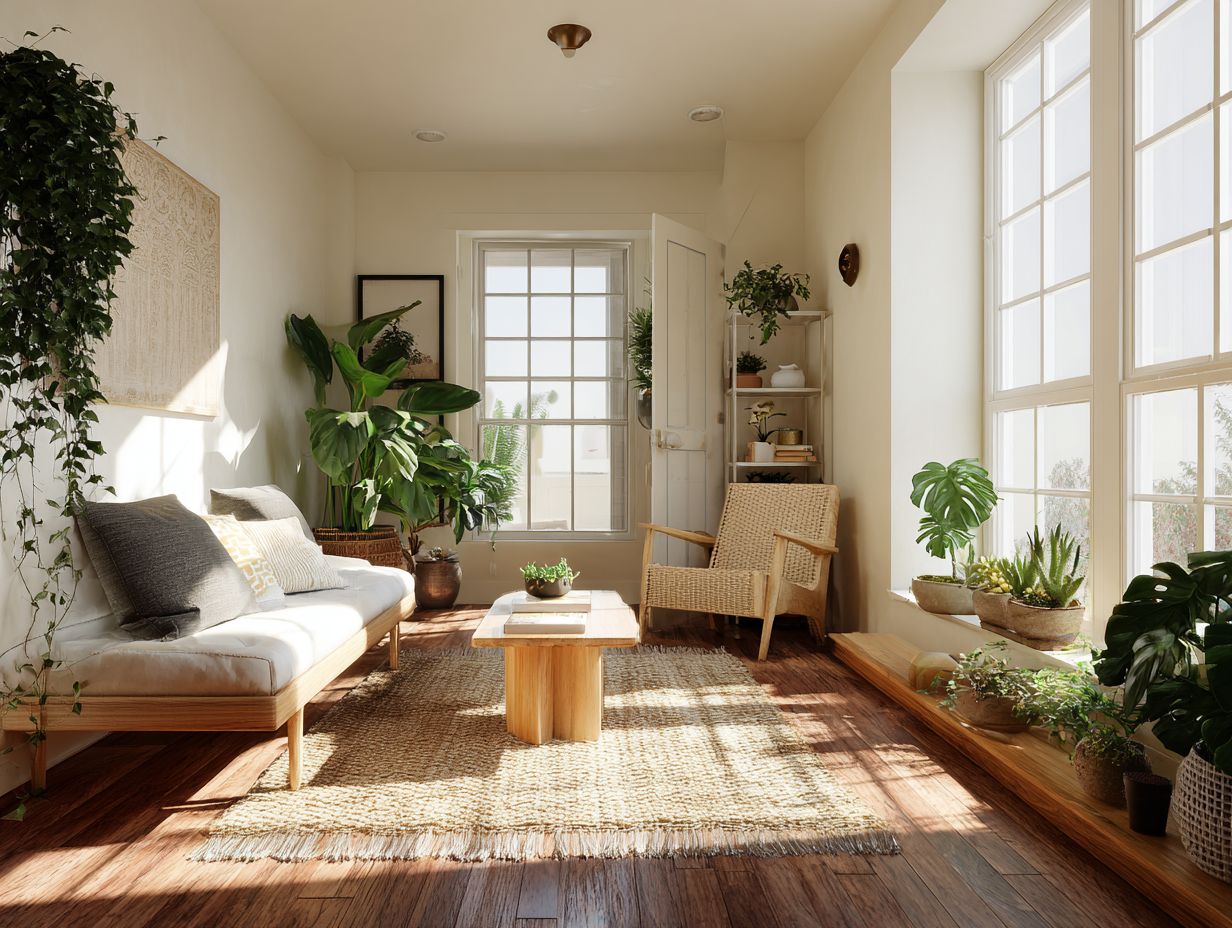
Another misconception is that non-toxic flooring lacks variety, whereas the market now offers extensive styles, colors, and materials to choose from.
For instance, hardwood options like bamboo and ash provide a timeless look while being eco-friendly. Cork, with its unique texture and affordability, adds warmth to any space and is also naturally resistant to mold and mildew.
Linoleum comes in many colors and designs, and is known for being sturdy and easy to care for. Brands like Armstrong and Forbo provide eco-friendly collections that improve visual appeal while focusing on sustainability.
This range helps homeowners find stylish and safe options that still look good.
Frequently Asked Questions
What are non-toxic flooring materials?
Non-toxic flooring materials are flooring options that do not contain harmful chemicals or toxins that can negatively impact the air quality and health of individuals living in a home.
Why should I choose non-toxic flooring materials for my home?
Choosing non-toxic flooring materials is important for promoting a healthier living environment, especially for those with allergies, respiratory issues, and sensitivities to chemicals. These materials also help to reduce the use of harmful chemicals in the production process and contribute to a more sustainable and eco-friendly home.
What are some examples of non-toxic flooring materials?
Some examples of non-toxic flooring materials include hardwood, bamboo, cork, linoleum, natural stone, and ceramic tiles. These materials are naturally sourced and do not contain harmful chemicals or toxins.
Are all non-toxic flooring materials expensive?
No, not all non-toxic flooring materials are expensive. There are affordable options available, such as linoleum and cork, which are both durable and eco-friendly. It is important to do research and compare prices to find the best option for your budget.
Can non-toxic flooring materials be used in all rooms of the house?
Yes, non-toxic flooring materials can be used in any room of the house, including kitchens and bathrooms. However, you should think about what each room needs when picking flooring.
Do non-toxic flooring materials require special maintenance?
Non-toxic flooring materials may require different maintenance compared to traditional flooring options. For example, hardwood floors may require occasional waxing, while linoleum may need to be sealed to protect it from moisture. Look into how each material needs to be cared for to make it last longer.
